Further Informtion on TIMEFRAME unit
The Timeframe unit was one of the items
donated to the Snooker Heritage Collection by the family of David
Smith.
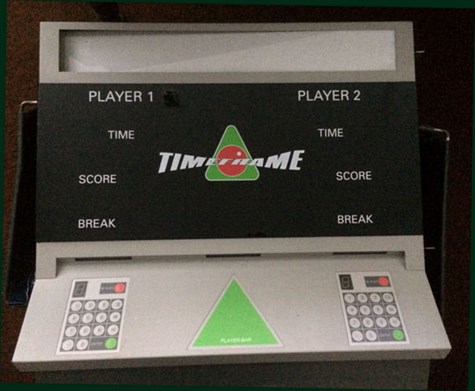
In June 2021 www.snookerheriatge.co.ukreceived an email from Mr. Ales Smith of
Dundee, Scotland. He had found the site as he was searching for any
mention of the 'TIMEFRAME' unit that he had designed all the
electronics for. He found the mention on the site and wrote to
introduce himself and correct the original article that sated the
units had been made in Leamington Spa .
He was able to confirm that they had
been made in Dundee - this fact has now been corrected in the
aricle /the-collection/additions/- see the David Smith
Collection.
Alex provided the following
information:-
I was just reminiscing, as you do, about times gone past and
decided to have a look to see if the Timeframe snooker scoreboard
was still remembered.
You have the board listed as being produced in Leamington Spa but
you might be interested to know it was first produced in Dundee in
Scotland.
I know this because I designed all the electronics used in the
machine at "Timeframe Ltd." Dundee.
The programming for the unit was written at "DMA Design" in
Dundee.
The same people that produced the "Lemmings" game.
You can easily verify my "designer" status by opening the box and
looking at the corners of any of the PCB's in it. You should find a
"Circle" logo with my initials (AYS) in it. Slight vanity on my
part, I'm afraid.
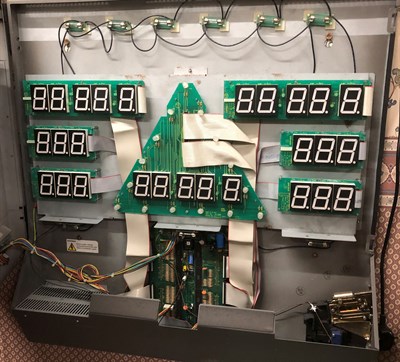
If you managed to get a later version of the machine, it also had
an infra red link for use with Pool tables to auto rotate the table
mechanism, so the game could continue 'till the playing time ran
down.
The machine used "tokens" to start a game off but that should be
easily bypassed.
Unfortunately, I don't have any physical parts of a machine, so
I'm hoping you might be able to take a couple of photographs of the
interior and send them to me?
Many thanks for the photos of the
internals of the Timeframe machine. I see my "AYS" logo everywhere,
so vanity is fulfilled.
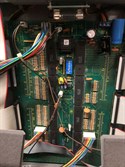
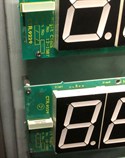
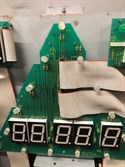
Brings back many memories as well as
showing up my sad lack of same, Re. parts of the
machine.
For example, the main board
shown in your img1540 tells me the board is an early version
WITHOUT the Pool table add on to auto rotate the Pool table
mechanism after all the balls were potted but time remained on the
display.
Also missing is the 9 pin
plug at J7 that was used (when fitted) as a serial interface to a
computer.
The 8 way Dip switch set timing on the
display.
I was inordinately chuffed
with this board as one of the Canadian engineers that stayed after
Discus folded said it was the most elegant PCB he had ever seen. No
wonder I had a big head !!!
I'm still getting a history
of the machine together and I'll get back to you when
done
A few days later Alex sent the following
information along with an USB stick which had a copy of the T.V.
Broadcast of the unit being used in a professional
tournament.
With all due respect to Sir Stephen
Hawking, I submit;
"A Brief History of
TIMEframe".
In 1990, I moved from Ferranti PLC in
Dundee, Scotland to Discus Satellites in Kilspindie Rd.
The company was run by Terry and
Margaret (Meg) Goldberg.
This company produced a Canadian
designed "high end" satellite receiver with a moving dish
system.
Unfortunately, Discus came on the scene
just as many other companies brought out other units and sales
never took off, so the company folded fairly quickly.
In 1991, "Timeframe Technology Ltd." was
born with the addition of two "silent" Directors. Ron and Chris
Bonar, very well respected names in Dundee.
Ron Bonar famously drove everywhere in a
Rolls Royce Silver Ghost and did sterling charity work,
particularly for the R.N.L.I.
Chris Bonar was and still is a World
renowned yachtsman and a member of Royal Tay Yacht Club.
As I had made some improvements on the
Discus Satellite Rx, including an electronic microprocessor
programming unit, Terry asked me to design the proposed Snooker
timer scoreboard electronics.
The machine was initially intended to
time a "Speed Snooker" match against the clock.
THREE clocks, actually!
A "Master" clock that could be set to
various times from 10 to 20 minutes and two "Player" clocks that
started from HALF the value of the "Master" clock.
"Score" & "Break" displays were
incorporated plus individual player keypads and a large triangular
impact resistant button to start the game and toggle between
players.
In 1991, there were almost no large LED
displays in the UK and pretty much no Yellow LEDs at all. Most LEDs
were no more than 0.5 inch (12mm), used in calculators and
clocks.
Timeframe was unique in not only having
both but DUAL COLOUR LEDs as well. The larger LEDs were specially
imported for "Timeframe"
The colours of the LEDs was influenced
by both Ron and Chris Bonar being Red/Green
colour-blind.
Timeframe also became the first
importers of Allegro Microsystems high power 32 bit serial to
parallel shift register Integrated Circuits to drive the 255
individual LEDs used in the machine.
To the CAD
software;
The internal boards were designed using
Tsien's Boardmaker 2 CAD software running on DOS 6.2 (remember
DOS?) with a "dongle" in the Parallel port of my PC (remember
Parallel ports?) to enable the software.
Three attempts produced a working main
board and a prototype was sent to DMA Design just down the road for
them to design the firmware for the machine. They, quite famously,
designed "Lemmings", a game that spread Worldwide.
From start to design finish, took
approximately three months.
The directors put together a television
deal to host the 1992 run of Pot Black as a "Timeframe"
competition.
This seemed to go quite well but if
truth be told, only John Parrot appeared to get into the swing of
it. I guess having a laugh wasn't to the fancy of the more "strait
laced" players?
Unfortunately, thereafter, due to what
seemed to be a lack of publicity, the Timeframe project faltered
and eventually died.
Of course, no boss could ever have
enough and Terry asked for a Serial Communications port to be added
to the mainboard.
There was an immediate request to get
the machine to handle "Pool" games as well and to that end, an
Infra Red link between the machine and a Pool table was designed.
This would send a signal to the pool table, that had been fitted
with an electric "ball drop" mechanism, so the game would continue
'till the "Master" clock ran down to zero.
However, these features were only built
into later versions of Timeframe.
The plan was to supply about 16 machines
to Dundee pubs for use in the Pool league, free of charge, to get
sales rolling but sadly, that never happened.
Your website indicated that the machines
had been produced in England but as far as I'm aware, they were
only ever MADE in Scotland.
'Timeframe' did sell off a fairly large
number of excess stock at the end, so that's when they might have
appeared in England.
I hope this "potted" history is of
use.
Alexander Y Smith,
Electronics designer,
Timeframe Technology,
Dundee.
Acknowledgement - Alexander Y
Smith
Copyright :- E.A. Clare & Son Ltd©2021 & Peter N.
Clare ©2021

